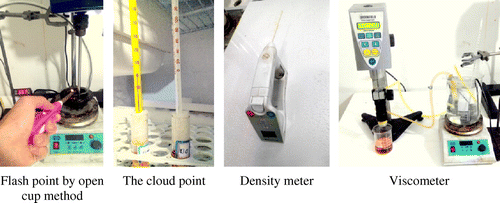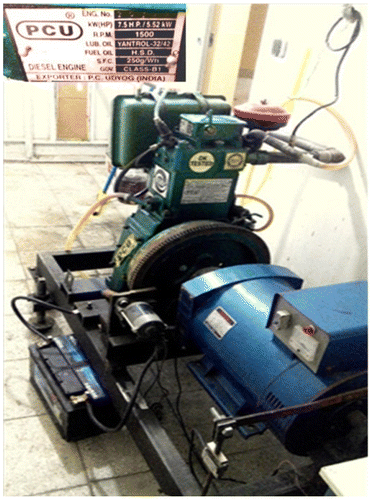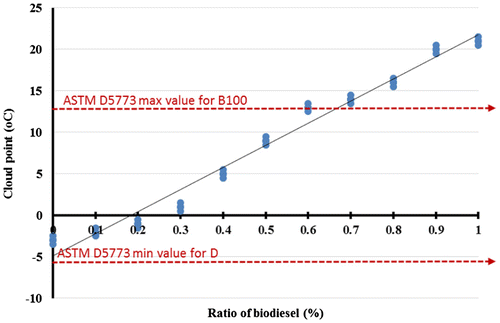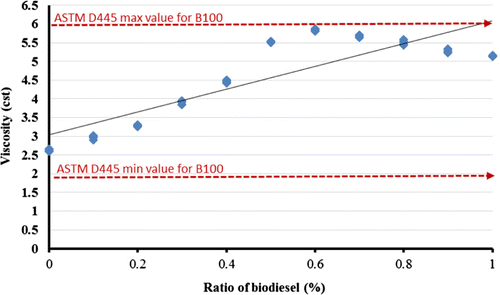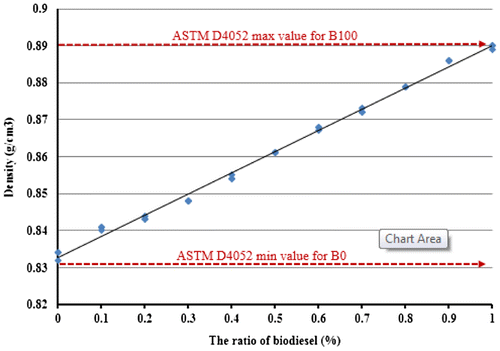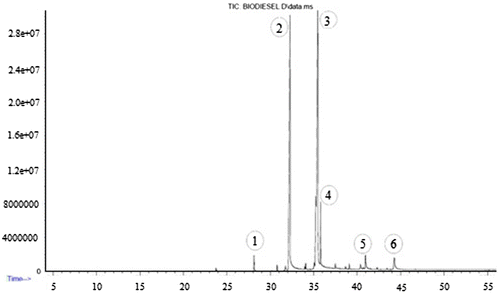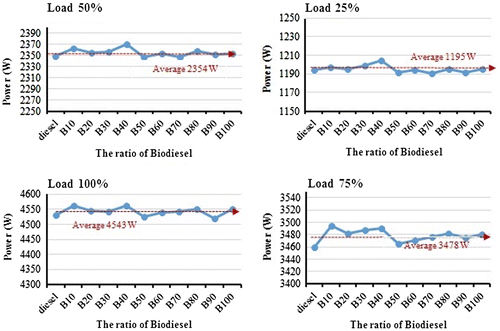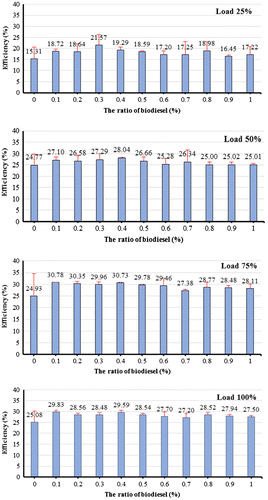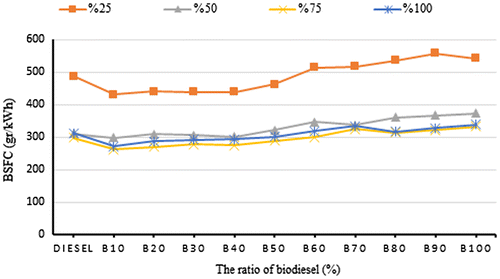 ?Mathematical formulae have been encoded as MathML and are displayed in this HTML version using MathJax in order to improve their display. Uncheck the box to turn MathJax off. This feature requires Javascript. Click on a formula to zoom.
?Mathematical formulae have been encoded as MathML and are displayed in this HTML version using MathJax in order to improve their display. Uncheck the box to turn MathJax off. This feature requires Javascript. Click on a formula to zoom.Abstract
Biodiesel is a biodegradable fuel contains fatty acid methyl or ethyl esters which are typically produced by the transesterification reaction among the triglycerides in the vegetable oils or animal fats and an alcohol such as methanol or ethanol. There are many resources of biodiesel production. In present study it was selected the palm oil to produce the ethyl ester biodiesel and the limiting factors for the use of palm oil biodiesel in a diesel engine in the context of the ASTM standards were discussed. Based on results, the maximum engine power is obtained in maximum load of engine and indicates no sensible change in engine power for biodiesel blends. Increasing the engine load decreases the Brake Special Fuel Consumption (BSFC). The best BSFC accrues in the range of B10–B40. The engine efficiency is increased by increasing load. The best efficiency is observed in range of 50–100% of engine load and the best efficiency is in range of B10–B40. Generally, by considering three parameters of engine power, BSFC and engine efficiency the B10 fuel of palm biodiesel offers the best performance, therefore it can be the recommended fuel for this study.
Public Interest Statement
In present study, the ethyl ester biodiesel is produced using palm oil. The produced biodiesel is blended with diesel fuel to prepare fuel samples and the prepared samples are studied from viewpoint of ASTM limitation for standard usable fuels. The properties of fuel samples were measured by ASTM standard. The results indicated that the thermophysical properties of palm biodiesel (including density, viscosity, cloud point and flash point) are within the standard range of ASTM. Based on results, the maximum engine power is obtained in the maximum load of engine and indicates no sensible change in engine power for fuel samples. The selected range of fuels from viewpoint of the lowest BSFC is related to range of B10–B40. The selected range of fuels from viewpoint of the engine efficiency is related to range of B10–B40 in 50–100% of engine load.
1. Introduction
Decreasing fossil fuel sources and increasing the cost of Oil and its derivatives from one hand and increasing the environmental crises on the other hand, make a challenge to produce less polluting alternative fuels. There are various ways to produce fuels but each way has its own limitations, opportunities, strengths and weaknesses that must be studied, evaluated and finally decided and selected (Khalife et al., Citation2017; Najafi, Pirouzpanah, Ghobadian, & Sadeghpour, Citation2007; Najafi, Pirouzpanah, Najafi, Yusaf, & Ghobadian, Citation2007).
The replacement of clean and renewable energies such as biodiesel can be very effective in solving these problems.
Iran despite being one of the producers of oil, provides a significant amount of its fuel through imports. On the other hand the low quality of the produced diesel in Iran is one of the significant factors to loss of the engine performance and to increase the environmental pollution in major cities. According to high consumption of diesel fuel and requirements to reduce the fossil fuels, it is necessary to pursue a fuel production technology in the medium and long term plans that does not require as much as possible fundamental changes in existing equipment and is similar to existing fuels (Ali, Mamat, Abdullah, & Abdullah, Citation2016).
One of the best alternatives to available fuel resources by considering the environmental approach and similarity to available resources, is the non-fossil and biofuels. Biodiesel is considered as a type of biofuels that is the best and suitable alternatives to fossil fuels in diesel engines which can be used in diesel engine in low mixing ratios. Biodiesel is a biodegradable fuel consists of fatty acid methyl or ethyl esters which are typically produced by the transesterification reaction among the triglycerides in the vegetable oils or animal fats and an alcohol such as methanol or ethanol (Gürü, Koca, Can, Çınar, & Şahin, Citation2010).
Biodiesel is a mixture of long-chain saturated and non-saturated fatty acid esters Mono Alkyl with high viscosity and density compared to diesel fuel (Mohammadi & Najafi, Citation2015).
The mixture of biodiesel and diesel is the common ways for overcoming the burning problems at low temperatures and improving the engine performance. Currently, fuel energy content is one of the main technical issues that says the use of biodiesel blend with high mixing ratio has a direct effect on the engine output power, its performance and emissions (Karmakar, Karmakar, & Mukherjee, Citation2010).
Therefore, with an overview of the present and future status of energy, the need for research on biodiesel recognition and how its production is clarified.
Some countries such as Argentina, Australia, Brazil, Belgium, Cambodia, Canada, China, Germany etc. now use biodiesel in combination with diesel fuel. This combination is approved as a fuel for diesel engines at a low blends up to 20% biodiesel (B20) according to ASTM D7467 standard (Chen, Huang, Chiang, & Tang, Citation2012). Accordingly it is used as a commercial fuel in many countries. Availability of raw materials of biofuels and their sustainability are the important determinant factors in generalization of the biodiesel (Vijayaraghavan & Hemanathan, Citation2009).
Rudolf diesel, diesel Engine Inventor, used the vegetable oil as alternative fuel in its compression engine for the first time. The biodiesel blend with diesel fuel is the most common method for using the biodiesel. Biodiesel can be blended with different proportions of diesel, which is used in many countries as commercial fuel (Vijayaraghavan & Hemanathan, Citation2009). Typically, biodiesel fuel energy content is lower than that of diesel fuel, due to its different chemical composition and increasing biodiesel ratio in the mixture with diesel fuel decreases the energy content of the blended fuel.
Biodiesel fuels (biodiesel fuel has unique properties based on its production resource that causes different effects on thermo physical properties and engine performance). There are different methods of biodiesel production include micro-emulsion (Amais, Garcia, Monteiro, & Nobrega, Citation2012; Bora, Boro, Konwar, & Deka, Citation2016; Nguyen, Do, & Sabatini, Citation2010; Pereira et al., Citation2016), Pyrolysis (Chang et al., Citation2017; Dong et al., Citation2015; Ito, Sakurai, Kakuta, Sugano, & Hirano, Citation2012; Laesecke, Ellis, & Kirchen, Citation2017) and various methods of trans-esterification process in presences or absence of catalyst (Carvalho, da Conceição, Silva, Perez, & de Castro, Citation2017; Delesma, Castillo, Sevilla-Camacho, Sebastian, & Muñiz, Citation2017; Zeng, Yang, & Fang, Citation2017; Zhou, Qiao, Li, Xue, & Yin, Citation2017).
There are many resources of biodiesel production, but the most common sources of biodiesel production are (Arbab et al., Citation2013): jatropha, coconut, palm, cottonseed, soybean, sunflower, canola or rapeseed, neem and rubber seed oil.
The quality of biodiesel is defined by its properties. American Society for Testing and Materials (ASTM) D6751 in the United States of America (A.S.f. Testing, Materials, Citation2012) and European Standard (EN) 14214 in Europe (E Standard EN14214, Citation2004) are considered as the international biodiesel standards (IBS) and also are factors to confirm the fuel properties. Various investigations reported the effects of physical properties of biodiesel on exhaust emissions and engine performance (Li et al., Citation2014; Rahman et al., Citation2014; Tesfa, Mishra, Gu, & Powles, Citation2010; Xing-cai, Jian-guang, Wu-gao, & Zhen, Citation2004).
The most important physical properties of biodiesel are Density (q), viscosity (l), cloud point (°C) and flash point (°C). This properties are the main factors to define the quality of fuels (Ramírez Verduzco, Citation2013). Table presents the properties of introduced common sources of biodiesel production (Arbab et al., Citation2013; D ASTM, 6751-03, Citation2007; Iqbal et al., Citation2015; McCarthy, Rasul, & Moazzem, Citation2011; Ozsezen, Canakci, Turkcan, & Sayin, Citation2009; Sanjid et al., Citation2013; Tang, Salley, & Simonng, Citation2008).
Table 1. The properties of common sources of biodiesel production
In present paper, palm oil was selected to produce biodiesel and to be studied through the study aims. Palm families are flowering plants. Currently 181 genera with around 2600 species are known. This plant are mostly growing in tropical and subtropical climates. The waste of palm oil can be used as biomass. Palm oil and palm kernel are obtained from palm plant which contains 40-50% oil. Palm oil contains palmitic saturated fatty acids, lauric and linoleic acids and unsaturated oleic acid (Sen, Longwic, Litak, & Górski, Citation2008).
There are many studies on biodiesel production of palm oil in basis of methyl ester but the number of studies on ethyl esters of palm oil and its effects on the engine performance are limited.
In a study by Suppalakpanya, Ratanawilai, and Tongurai (Citation2010a), it was investigated the production of palm oil ethyl ester and it was obtained a yield of 85 wt.% with an ester content of 98.1 wt.%. In other study by Suppalakpanya, Ratanawilai, and Tongurai (Citation2010b) it was investigated the ethyl esters of palm oil with a high free fatty acid content in a two-step process. This two-step esterification and transesterification processes provided a yield of 80 wt.% with an ester content of 97.4 wt.%. Silva et al. (Citation2014) studied the synthesis of pineapple flavor in esterification process of butanol and ethyl esters in transesterification of macaw palm pulp and macaw palm kernel oils with ethanol. The biocatalyst prepared attained transesterification yield of 50% after 48 h of reaction for macaw palm kernel oil and 35% after 96 h of reaction for macaw palm pulp oil. Nikhom and Tongurai (Citation2014) used continuous deglycerolisation to produce the ethyl ester biodiesel of palm oil. Based on results the ester content and yield were 98.0 wt.% and 93.1 wt.%, respectively. Poppe et al. (Citation2015) produced ethyl ester from olive and palm oils through transesterification process. Based on results repeated-batch processes showed 80% of their initial activity after seven cycles. Vieira da Silva, Lagnier Gil Ferreira, da Costa Marques, Lamare Soares Murta, and Vasconcelos de Freitas (Citation2017) compared the NOx emissions of biodiesel-diesel blends from soybean, palm and waste frying oils through transesterification process by methanol and ethanol. Based on results, 20% soybean methyl ester presented lowest emissions compared to the reference fuel and 20% palm methyl ester had the highest NOx emission but blends with palm ethyl ester were among blends with best emissions at all loads. de Almeida, García-Moreno, Guadix, and Guadix (Citation2015) studied the effect of palm oil biodiesel (ethyl and methyl esters) on CO2 emissions characteristics of an internal combustion engines. Abu-Hamdeh and Alnefaie (Citation2015) studied the performance and emission characteristics of a single cylinder diesel engine which was operated by almond and palm oil biodiesels and compared them, which almond biodiesel improved the engine performance compared to palm oil biodiesel.
Palm oil biodiesel contains some advantages and disadvantages for using in engine. Palm oil has high biodiesel production yield compared to other resources. Using palm oil biodiesel does not increase the level of engine emissions except NOx (Lim & Teong, Citation2010). Palm oil biodiesel, due to its high oxidation stability, increases NOx emission (Lozada, Islas, & Grande, Citation2010). It provides high ignition quality in engine. On the other hand the cost of preparing palm oil biodiesel is lower than that of other resources for biodiesel production.
Based on conducted studies, they didn’t discuss on different production conditions and their relations with relative standards and they did’t discuss in details. The aim of this research work is to study the limiting factors for the use of palm oil biodiesel in a diesel engine in the context of the ASTM standards and to discuss in detail, such that, this can be the main novelty of study. Determination of this factors helps to produce and use more efficiently within the framework of standards. And the other aim of this study was to do the engine test with different blends of diesel-biodiesel of palm ethyl ester.
2. Material and methods
2.1. Biodiesel production and preparing samples of fuel blends
In present study, biodiesel from palm oil was produced from ethanol in presence of NaOH catalyst through transesterification process. Accordingly, the oil was heated to 70°C and was stirred with a mixture in 600 rpm. In other container ethanol was heated to 70°C as a third of the initial oil weight (that was equal to molar ratio of alcohol to oil by 6:1) in presence of NaOH catalyst by the 0.1 wt.% of oil weight. Then the solution of alcohol and catalyst was added to oil and the solution was mixed for 30 min at temperature of 70°C by 600 rpm. After 8 hours, the temperature of solution was decreased to environment temperature (25°C). Then the acidity of the solution was measured and adjusted to pH of 7 by adding chloride acid of 46%. To separate the alcohol and glycerin, the solution was washed 3 times with water. Washing process was performed using water in temperature of 50°C by the gravity method during a period of 12 h (Figure ).
In order to prepare the fuel samples, the produced biodiesel of palm oil was blended by diesel in 10, 20, 30, 40, 50, 60, 70, 80 and 90 vol.% and the pure diesel fuel was used as controlling fuel.
2.2. Measuring biodiesel fuel properties
The biodiesel of each oil has its own and different properties. Because each of them has different percent of fatty acid mono esters such as palmetic, stearic, linoleic and oleic. The existence and share of each of them inside the fuel affects its thermo-physical properties. In other words, the thermophysical properties of biodiesel depend on the amount of each of these monounsaturated fatty acids. In this study, the properties of biodiesel fuel produced from palm oil were measured and evaluated based on ASTM standards. Thermophysical properties include: cloud point, flash point, viscosity and density. GCmass gas chromatography test was employed to determine the percentage of fatty acids present in biodiesel fuel.
2.3. The standard of measuring the flash point
Flash point is the lowest temperature that the fuel vapors are instantaneously ignited in the laboratory conditions, and according to ASTM D6751 standard, it is conducted by open cup method (A. Standard, D6751, Citation2012). The 50 cc of fuel is placed in the cup and placed on the heater, and the thermometer is placed in the middle of the solution suspended in a manner that does not touch the cup and only shows the temperature of the fuel. As the fuel temperature increases, the flame is slowly passed through the surface of the sample (Figure ). If the fuel vapor flashes instantaneously, the corresponding temperature is recorded as the flash point. The tests were performed on three repetitions and since the standard lighting point should be reported at sea level pressure, the following formula is used to determine the corrected flash point:(1)
(1)
where FP is the corrected flash point (°C), C is the flash point of test (°C) and P is the pressure of test place (mm Hg).
2.4. The standard of measuring the cloud point
The cloud point is considered as the limiting characteristics of using biodiesel in low temperatures. Because cooling the biodiesel makes its molecules waxy which disrupts the transfer of fuel from the reservoir to other parts. The cloud point is a temperature to observe the wax particles. The cloud point is determined by ASTM D5773 standard with observing the transparency of the fuel that cools under controlled conditions (A. Standard, D5773, Citation2007). The sample is poured into a glass cylinder and, in order to create the homogeneous conditions in the fuel, the temperature is brought to 40°C using an oven. The samples be placed outside of the oven in a container of water and ice. By decreasing the temperature, the first wax crystals in the solution be observed and the cloud point temperature be recorded (Figure ).
2.5. The standard of measuring the density
The fuel density is important in atomization in combustion process. The density of fuel is determined by ASTM D4052 standard at temperature of 25°C. In present study the density of fuel and its blends were measured by DA-130 N density meter in three repetitions (Figure ) (A.S.f. Testing, Materials, ASTM D4052, Citation2009). The accuracy of the instruments for measuring the density of samples is equal to ± 0.001 gr/cm2.
2.6. The standard of measuring the viscosity
Viscosity is the important parameter in injection process. The viscosity in addition to determine the lubrication ability of engine parts, effects the atomization of fuel in combustion chamber (Aydin & Bayindir, Citation2010; Ramadhas, Muraleedharan, & Jayaraj, Citation2005; Utlu & Koçak, Citation2008).
The measuring of biodiesel viscosity is performed at temperature of 40°C by ASTM D445 standard (A. Standard, D445, Citation2006). In present study, the DV-II Prime Brookfield viscometer was used with two UAL adaptor (Figure ).
2.7. Measuring the chemical compounds of biodiesel using gas chromatography (GC) method
The GC of Agilent technologies 7890A GC System was employed to identify and determine the chemical compounds of biodiesel according to ASTM6584 and EN14214 standards. In this method, the materials are separated from each other by the number of their constituent atoms and also in proportion to their molecular weight.
2.8. The experimental setup of engine test
In this study, it was used the single cylinder Margo engine, a four-stroke naturally aspirated and direct injection engine. The engine had constant speed of 1,500 rpm with maximum power of 5.5 kW. The diameter of piston was 87.5 mm, the piston course was 110 mm and the compression ratio was 17.5. In order to measure the power, it was joined to a jb/t-200 electricity generator. The generator was suspended to the engine’s output shaft and its body was connected to a 200 kN load cell by a 30 cm long arm. The variable resistance of TDGC2-5KVA was used to take the engine under load. The fuel consumption is also measured by calibrated cylinder method. The tests were performed based on short-term engine testing at speed of 1,500 rpm and loads of 10, 25, 50, 75 and 100% of full load (Figure ).
3. Results and discussion
3.1. The properties of blends of palm oil biodiesel and diesel
In present study, the properties of prepared fuels were determined by ASTM standard and the prepared fuels were tested.
3.2. Flash point
The test of measuring the Flash point were performed in five repetitions (Figure ). Based on Figure , increasing the ratio of biodiesel in diesel increases the flash point. The increasing is limited until B60 and then the variation slop is faster. i.e. in low ratios of biodiesel in diesel, values of the flash point are almost same as diesel and there is not much difference between them. But increasing the ratios of biodiesel in diesel increases the flash point such the pure biodiesel has the highest value of flash point. This increase in flash point can be because of the difference in values of fatty acids and the type of alcohol in fuel production. The high flash point makes a safety transport and decreases the maintenance cost. Also, the high value of flash point makes ignition delay in engine that is the most important factor in evaluating the fuel quality. Figure indicates the flash point of pure biodiesel of palm oil is 185°C and is in range of ASTM D93 standard (A. Standard, D93, Citation2008). This standard determines the Min allowed flash point by 70 and 120°C for diesel and biodiesel, accordingly.
3.3. Cloud point
Based on Figure , increasing the ratio of biodiesel in diesel fuel, increases the cloud point. The cloud point is one of the environmental limiting factors. In present study, cloud point was measured by −4 to 21°C. The results of tests indicate increasing the cloud point has a linear relation with ratio of biodiesel in diesel and the pure biodiesel has the highest cloud point. Based on the standard of ASTM D5773, the maximum cloud point of pure diesel is 12°C that the samples are in this range up to B60 and the pure biodiesel is not in this range (A. Standard, D5773, Citation2007). This is the most important weak point of palm oil biodiesel. This says the use of palm oil biodiesel in cold regions and in cold seasons is not suitable, however the using additives such as alcohol or using heaters in fuel reservoir corrects this temperature.
3.4. Viscosity
In diesel engines the fuel must be lubricate the injection pump. Viscosity is a factor that effect on this characteristics of diesel fuel. Also, this factor effects on injection pressure, the diameter of injected particles and the penetration of them into the combustion chamber.
The results of viscosity measuring was presented in five repetitions for ratios of biodiesel in diesel. The viscosity of pure biodiesel in this study was 5.15 cst. The standard range of ASTM D445 for measuring the biodiesel is 1.9–6 cst that the palm biodiesel viscosity is in this range (A. Standard, D445, Citation2006). The high value of density of biodiesel and presence of impurities increases the viscosity and according to Figures and , the ratio of biodiesel in diesel has the direct impact on viscosity and density. The results shows, the increase of biodiesel ratios up to B60 increases the viscosity and then decreases. The maximum viscosity is 5.84 cst that is related to B60 and the minimum value is related to B10.
3.5. Density
Biodiesel is composed of long hydrocarbon chains compared to diesel fuel. Therefore its density is higher than that of biodiesel. Density is one of the important factors in increasing viscosity and decreasing the atomization of fuel in combustion chamber and impacts on chamber temperature (Santos et al., Citation2014).
The reduction of engine power and increasing the fuel consumption is due to the lowest heating value of biodiesel but the high value of density that compensates the low heating value of this fuel (Baiju, Naik, & Das, Citation2009; Zulkifli, Kalam, Masjuki, Shahabuddin, & Yunus, Citation2013).
The density of biodiesel is lower than that of biodiesel and adding the biodiesel to diesel increases the fuel density. The standard value of density based on ASTM D4052 standard for biodiesel is in range of 0.86 to 0.89 gr/cm3 (A.S.f. Testing, Materials, ASTM D4052, Citation2009).
In this study the density of pure biodiesel was measured as 0.892 gr/cm3 and density of B20 was measured as 0.839 gr/cm3 that is in range of standard. According to the results of Figure , increasing the ratio of biodiesel in diesel increases the density, linearly, i.e. the ratio of biodiesel has direct impact on density. The high value of density of biodiesel increases the viscosity. In case of biodiesel, choosing the production method has the main impact on final value of viscosity. In general, the produced biodiesel from various sources has different value of viscosity and it is depend on the density of the used oil. The high values of mono and di glycerides in fuel also effect on density of fuel.
The various tests on biodiesel and its blends with diesel shows the appropriate quality of produced biodiesel based on standards. Therefore it can be used the biodiesel blends of palm in diesel engine. The results of the studies on the biodiesel properties of palm oil were tabulated in Table . In general, the values shows the appropriate quality of production biodiesel.
Table 2. The properties of fuel blends of biodiesel in diesel
3.6. The chromatography test
In order to determine the components of biodiesel blends it was used the chromatography test. This test obtains the triglycerides, di glycerides and mono glycerides of biodiesel. The detection mechanism is based on the passage of matter from the identifier at the end of the chromatography column. The molecules move in a column based on their polarity in different times. Increasing the polarization of molecules spends the more time to cross the column and pass through the detector.
Based on Figure , the biodiesel consists of six different combinations (the six main peak point).
The area under each peak presents the presence percent of relative combination. The third peak is related to ethyl oleat that is assigned the highest area to itself and be included the 52% of biodiesel. The biodiesel purity percentage, by considering the area under the curve is 99% that is presented in Table .
The molecular structure of biodiesel is consists of three elements include carbon, oxygen and hydrogen. Monoglycerides and triglycerides are the major impurities in biodiesel.
The amount of these impurities are in range of EN14214 and ASTM D6584 standards and cover the standard limitation (A. Standard, D6584, Citation2008; E Standard EN14214, Citation2004). The results of Table shows the high ratio of oleate (52.89%). Ethyl palmitate was in second stage by 41.65 and ethyl stearate and ethyl myristate were on third and fourth stages by 3.63 and 1.11%, respectively. According to the percent of esters of biodiesel it was taken the C19H37O2 formula for palm oil biodiesel.
Table 3. The composition and ratio of the materials obtained from the chromatographic test
3.7. The results of experimental tests of engine performance
In order to perform the test of engine performance, the prepared blends were tested on different loads. The test conditions included the measurable parameters include the fuel type and the brake load on the engine. The speed of the engine was fixed at 1,500 rpm during the test. The results and data of measuring fuel samples and the results of engine test were studied and evaluated after extracting figures to compare the effect of independent variables on fuel properties. Some of physical properties of biodiesel were determined based on ASTM standard. The produced biodiesel was mixed by diesel in various ratios of vol.% as study samples and the effect of prepared samples on engine performance was studied. Based on mentioned results, some of properties of pure biodiesel may create problem in engine performance such as cloud point and may need special condition to use but in low blends of biodiesel in diesel, it can be the best alternative fuel to pure diesel fuel. Because it is similar to diesel in case of effect on engine performance and can improve the combustion process due to presence of oxygen.
According to Figure , the fuel in range of B10–B50 can be the best alternatives to diesel fuel because they have similar performance and low BSFC (Brake Special Fuel Consumption). Therefore, the blends of the palm oil biodiesel in diesel fuel is recommended for using in diesel engine tests.
The main factor in performance of biodiesel fuel includes the high content of oxygen in molecular structure of biodiesel, the high value of flash and cloud points, density and viscosity compared to diesel fuel in combination with diesel fuel which some of them are varying in proportion to the ratio of biodiesel in the fuel blends. Generally, the oxygen content helps to do a comprehensive combustion and reduce the pollutions. The high value of flash point causes self-ignition delay that causes the increase of pressure on the piston but if this delay be too long, the temperature and maximum pressure be reduced and performance of the engine will be decreased .
The high value of density and viscosity has the negative impact on fuel atomization and reduces the combustion temperature that increases some pollutants, because the nitrogen oxides need the high temperature to be generated and generates unburned hydro carbons (UHC) and CO at low temperatures.
3.8. Engine power
Figure shows the relation of engine power with biodiesel in fuel blends and load. Based on results, increasing the engine load increases the engine power but the impact of power in ratios of biodiesel has no significant variations. Based on results of load effect, the engine brake power. Generally, the difference of values for biodiesel ratio in fuel blends was insignificant that shows the use of biodiesel ratios in fuel blends don’t have significant impact on engine power but as seen on Figure , B10 and B40 have the highest values. B40 produces the maximum power and B90 produces the minimum power. The trend of power production is increasing up to B40 but from B50 to B100 is decreasing that is because of increasing the viscosity and accordingly decreasing the atomization and its combustibility with air.
3.9. Engine performance efficiency
In evaluating the engine performance efficiency with different ratios of palm biodiesel, the results were presented in Figure that shows the efficiency of fuel blends on different loads and repetitions. In the general condition of the test, the results of the Figure indicate a relative increase in the efficiency with increasing load, and in the no load state it was obtained the lowest efficiency. The lowest efficiency was related to B0 and the maximum efficiency was related to range of B10–B40.
3.10. BSFC (Brake Special Fuel Consumption)
BSFC is the factor that shows the fuel consumption for producing the 1 kW of power. The BSFC has a direct relation with density of fuel and has an inverse relation with heating value of fuel. Decreasing the BSFC increases the heating efficiency of engine. In other hand high heating value and low quality of combustion increases the BSFC.
Generally, the biodiesel fuel and its blends with diesel fuel have similar BSFC in present study, because from one hand the density of diesel fuel is lower than that of biodiesel but it has high heating value compared to biodiesel and on the other hand the combustion quality of biodiesel due to its oxygen content is higher than that of diesel fuel. The BSFC in all samples of fuels is increased with a snooze slope because the biodiesel has the high viscosity compared to diesel fuel but it has the low heat value and this makes an interaction. Figure presents the BSFC for fuel blends in different loads which increasing the load, decreases BSFC. The highest BSFC is related to no load state and from a load of 50 to 100%, there was no significant impact on BSFC. As a result, it is suggested to use the engine in 50, 75 and 100% of engine load. Increasing the engine load increases the engine power and increasing the load decreases the BSFC, therefore it can be said that increasing the engine power decreases the BSFC.
4. Conclusion
The palm oil is obtained from the fruit of an oily palm and includes the non-saturated palmetic fatty acid that its name (Palm) is because of its oil type. Pretense of this fatty acid gives unique thermo-physical properties to biodiesel. In present study, biodiesel was produce through transesterification process from palm oil and then the produced biodiesel was blended with diesel in different ratios (10, 20, 30, 40, 50, 60, 70, 80, 90 and 100 vol.%). The properties of fuel samples were measured by ASTM standard. The results indicated that the thermophysical properties of palm biodiesel (Density, viscosity, cloud point and flash point) covers the ASTM standards. Also, results indicated, increasing the blends of biodiesel in diesel, increases the density, viscosity, cloud point and flash point compared to pure diesel. The results of engine performance test with prepared fuel samples show the maximum engine power in maximum load of engine and indicate no sensible change in engine power for biodiesel blends. And also increasing the engine load decreased the BSFC. The best BSFC was in the range of B10–B40.
The engine efficiency was increased by increasing load. The best efficiency was observed in range of 50–100% of engine load and the best efficiency was in range of B10–B40. Generally, by considering three parameters of engine power, BSFC and engine efficiency the B10 fuel of palm biodiesel offered the best performance, and it was recommended fuel for this study.
Funding
The authors received no direct funding for this research.
Additional information
Notes on contributors
Jalal Ghazanfari
Jalal Ghazanfari revived Master of Science degree from University of Mohaghegh Ardabili in Ardabili province of Iran. His Major research interests are Biofuels and environmental science.
Bahman Najafi
Bahman Najafi is associate professor of renewable energies of University of Mohaghegh Ardabili in Ardabili province of Iran. He is now working on biofuels including biodiesel, biogas and biohydrogen.
Sina Faizollahzadeh Ardabili
Sina Faizollahzadeh Ardabili is PhD candidate of renewable energies in University of Mohaghegh Ardabili. His research interests are biofuels, environmental sciences, soft-computing methods, Exergetcal approach and energy managements. he is now working on thermophysical properties of Biodiesel (methyl or ethyl esters).
Shahaboddin Shamshirband
Shahaboddin Shamshirband’s primary research area lies within computational intelligence, multi agent systems, and machine learning in engineering applications of artificial intelligence. He is a of IEEE.
References
- A. Standard, D445. (2006). Standard test method for kinematic viscosity of transparent and opaque liquids (and calculation of dynamic viscosity). West Conshohocken, PA: American Society for Testing and Materials.
- A. Standard, D5773. (2007). Standard test method for cloud point of petroleum products (constant cooling rate method). West Conshohocken, PA (USA): ASTM.
- A. Standard, D6584. (2008). Standard test method for determination of free and total glycerin in b-100 biodiesel methyl esters by gas chromatography. West Conshohocken, PA: American Society for Testing and Materials.
- A. Standard, D6751. (2012). Standard specification for biodiesel fuel blend stock (B100) for middle distillate fuel. West Conshohocken, PA: ASTM International. doi:10.1520/D651-12
- A. Standard, D93. (2008). Standard test methods for flash point by Pensky–Martens closed cup tester. West Conshohocken, PA: American Society for Testing and Materials.
- Abu-Hamdeh, N. H., & Alnefaie, K. A. (2015). A comparative study of almond and palm oils as two bio-diesel fuels for diesel engine in terms of emissions and performance. Fuel, 150, 318–324.
- Ali, O. M., Mamat, R., Abdullah, N. R., & Abdullah, A. A. (2016). Analysis of blended fuel properties and engine performance with palm biodiesel–diesel blended fuel. Renewable Energy, 86, 59–67.
- Amais, R. S., Garcia, E. E., Monteiro, M. R., & Nobrega, J. A. (2012). Determination of Ca, Mg, and Zn in biodiesel microemulsions by FAAS using discrete nebulization. Fuel, 93, 167–171.
- Arbab, M., Masjuki, H., Varman, M., Kalam, M., Imtenan, S., & Sajjad, H. (2013). Fuel properties, engine performance and emission characteristic of common biodiesels as a renewable and sustainable source of fuel. Renewable and Sustainable Energy Reviews, 22, 133–147.
- A.S.f. Testing, Materials. (2012). Standard specification for biodiesel fuel blend stock (B100) for middle distillate fuels. West Conshohocken, PA: ASTM International.
- A.S.f. Testing, Materials, ASTM D4052. (2009). Standard test method for density and relative density of liquids by digital density meter. West Conshohocken, PA: ASTM.
- Aydin, H., & Bayindir, H. (2010). Performance and emission analysis of cottonseed oil methyl ester in a diesel engine. Renewable Energy, 35, 588–592.
- Baiju, B., Naik, M., & Das, L. (2009). A comparative evaluation of compression ignition engine characteristics using methyl and ethyl esters of Karanja oil. Renewable Energy, 34, 1616–1621.
- Bora, P., Boro, J., Konwar, L. J., & Deka, D. (2016). Formulation of microemulsion based hybrid biofuel from waste cooking oil–A comparative study with biodiesel. Journal of the Energy Institute, 89, 560–568.
- Carvalho, A. K. F., da Conceição, L. R. V., Silva, J. P. V., Perez, V. H., & de Castro, H. F. (2017). Biodiesel production from Mucor circinelloides using ethanol and heteropolyacid in one and two-step transesterification. Fuel, 202, 503–511.
- Chang, J.-S., Cheng, J.-C., Ling, T.-R., Chern, J.-M., Wang, G.-B., Chou, T.-C., & Kuo, C.-T. (2017). Low acid value bio-gasoline and bio-diesel made from waste cooking oils using a fast pyrolysis process. Journal of the Taiwan Institute of Chemical Engineers, 73, 1–11.
- Chen, Y.-H., Huang, B.-Y., Chiang, T.-H., & Tang, T.-C. (2012). Fuel properties of microalgae (Chlorella protothecoides) oil biodiesel and its blends with petroleum diesel. Fuel, 94, 270–273.
- D ASTM, 6751-03. (2007). Standard specification for biodiesel fuel blend stock (B100) for middle distillate fuels. West Conshohocken, PA: ASTM International.
- de Almeida, V. F., García-Moreno, P. J., Guadix, A., & Guadix, E. M. (2015). Biodiesel production from mixtures of waste fish oil, palm oil and waste frying oil: Optimization of fuel properties. Fuel Processing Technology, 133, 152–160.
- Delesma, C., Castillo, R., Sevilla-Camacho, P., Sebastian, P., & Muñiz, J. (2017). Density Functional study on the transesterification of triacetin assisted by cooperative weak interactions via a gold heterogeneous catalyst: Insights into biodiesel production mechanisms. Fuel, 202, 98–108.
- Dong, T., Gao, D., Miao, C., Yu, X., Degan, C., Garcia-Pérez, M., … Chen, S. (2015). Two-step microalgal biodiesel production using acidic catalyst generated from pyrolysis-derived bio-char. Energy Conversion and Management, 105, 1389–1396.
- E Standard EN14214. (2004). Automotive fuels-fatty acid methyl esters (FAME) for diesel engines, requirements and test methods.
- Gürü, M., Koca, A., Can, Ö., Çınar, C., & Şahin, F. (2010). Biodiesel production from waste chicken fat based sources and evaluation with Mg based additive in a diesel engine. Renewable Energy, 35, 637–643.
- Iqbal, M. A., Varman, M., Hassan, M. H., Kalam, M. A., Hossain, S., & Sayeed, I. (2015). Tailoring fuel properties using jatropha, palm and coconut biodiesel to improve CI engine performance and emission characteristics. Journal of Cleaner Production, 101, 262–270.
- Ito, T., Sakurai, Y., Kakuta, Y., Sugano, M., & Hirano, K. (2012). Biodiesel production from waste animal fats using pyrolysis method. Fuel Processing Technology, 94, 47–52.
- Karmakar, A., Karmakar, S., & Mukherjee, S. (2010). Properties of various plants and animals feedstocks for biodiesel production. Bioresource Technology, 101, 7201–7210.
- Khalife, E., Kazeroni, H., Mirsalim, M., Shojaei, T. R., Mohammadi, P., Salleh, A. M., … Tabatabaei, M. (2017). Experimental investigation of low-level water in waste-oil produced biodiesel-diesel fuel blend. Energy.
- Laesecke, J., Ellis, N., & Kirchen, P. (2017). Production, analysis and combustion characterization of biomass fast pyrolysis oil–Biodiesel blends for use in diesel engines. Fuel, 199, 346–357.
- Li, R., Wang, Z., Ni, P., Zhao, Y., Li, M., & Li, L. (2014). Effects of cetane number improvers on the performance of diesel engine fuelled with methanol/biodiesel blend. Fuel, 128, 180–187.
- Lim, S., & Teong, L. K. (2010). Recent trends, opportunities and challenges of biodiesel in Malaysia: An overview. Renewable and Sustainable Energy Reviews, 14, 938–954.
- Lozada, I., Islas, J., & Grande, G. (2010). Environmental and economic feasibility of palm oil biodiesel in the Mexican transportation sector. Renewable and Sustainable Energy Reviews, 14, 486–492.
- McCarthy, P., Rasul, M., & Moazzem, S. (2011). Analysis and comparison of performance and emissions of an internal combustion engine fuelled with petroleum diesel and different bio-diesels. Fuel, 90, 2147–2157.
- Mohammadi, S., & Najafi, B. (2015). Prediction of Cetane number of biodiesel fuel from fatty acid ethyl ester (FAEE) composition. Indian Journal of Science and Technology, 8.
- Najafi, B., Pirouzpanah, V., Ghobadian, B., & Sadeghpour, R. A. (2007). Experimental investigation of diesel engine performance parameters and pollution using biodiesel.
- Najafi, B., Pirouzpanah, V., Najafi, G., Yusaf, T., & Ghobadian, B. (2007). Experimental investigation of performance and emission parameters of a small diesel engine using CNG and biodiesel (SAE Technical Paper).
- Nguyen, T., Do, L., & Sabatini, D. A. (2010). Biodiesel production via peanut oil extraction using diesel-based reverse-micellar microemulsions. Fuel, 89, 2285–2291.
- Nikhom, R., & Tongurai, C. (2014). Production development of ethyl ester biodiesel from palm oil using a continuous deglycerolisation process. Fuel, 117, 926–931.
- Ozsezen, A. N., Canakci, M., Turkcan, A., & Sayin, C. (2009). Performance and combustion characteristics of a DI diesel engine fueled with waste palm oil and canola oil methyl esters. Fuel, 88, 629–636.
- Pereira, T. C., Conceição, C. A., Khan, A., Fernandes, R. M., Ferreira, M. S., Marques, E. P., & Marques, A. L. (2016). Application of electrochemical impedance spectroscopy: A phase behavior study of babassu biodiesel-based microemulsions. Spectrochimica Acta Part A: Molecular and Biomolecular Spectroscopy, 168, 60–64.
- Poppe, J. K., Matte, C. R., Peralba, M. D. C. R., Fernandez-Lafuente, R., Rodrigues, R. C., & Ayub, M. A. Z. (2015). Optimization of ethyl ester production from olive and palm oils using mixtures of immobilized lipases. Applied Catalysis A: General, 490, 50–56.
- Rahman, M., Pourkhesalian, A., Jahirul, M., Stevanovic, S., Pham, P., Wang, H., … Ristovski, Z. (2014). Particle emissions from biodiesels with different physical properties and chemical composition. Fuel, 134, 201–208.
- Ramadhas, A., Muraleedharan, C., & Jayaraj, S. (2005). Performance and emission evaluation of a diesel engine fueled with methyl esters of rubber seed oil. Renewable Energy, 30, 1789–1800.
- Ramírez Verduzco, L. F. R. (2013). Density and viscosity of biodiesel as a function of temperature: Empirical models. Renewable and Sustainable Energy Reviews, 19, 652–665.
- Sanjid, A., Masjuki, H., Kalam, M., Rahman, S. A., Abedin, M., & Palash, S. (2013). Impact of palm, mustard, waste cooking oil and Calophyllum inophyllum biofuels on performance and emission of CI engine. Renewable and Sustainable Energy Reviews, 27, 664–682.
- Santos, A., Souza, L., Caldeira, V., Farias, M., Fernandes, V., & Araujo, A. (2014). Kinetic study and thermoxidative degradation of palm oil and biodiesel. Thermochimica Acta, 592, 18–22.
- Sen, A. K., Longwic, R., Litak, G., & Górski, K. (2008). Analysis of cycle-to-cycle pressure oscillations in a diesel engine. Mechanical Systems and Signal Processing, 22, 362–373.
- Silva, N. C., Miranda, J. S., Bolina, I. C., Silva, W. C., Hirata, D. B., de Castro, H. F., & Mendes, A. A. (2014). Immobilization of porcine pancreatic lipase on poly-hydroxybutyrate particles for the production of ethyl esters from macaw palm oils and pineapple flavor. Biochemical Engineering Journal, 82, 139–149.
- Suppalakpanya, K., Ratanawilai, S., & Tongurai, C. (2010a). Production of ethyl ester from esterified crude palm oil by microwave with dry washing by bleaching earth. Applied Energy, 87, 2356–2359.
- Suppalakpanya, K., Ratanawilai, S., & Tongurai, C. (2010b). Production of ethyl ester from crude palm oil by two-step reaction with a microwave system. Fuel, 89, 2140–2144.
- Tang, H., Salley, S. O., & Simonng, K. S. (2008). Fuel properties and precipitate formation at low temperature in soy-, cottonseed-, and poultry fat-based biodiesel blends. Fuel, 87, 3006–3017.
- Tesfa, B., Mishra, R., Gu, F., & Powles, N. (2010). Prediction models for density and viscosity of biodiesel and their effects on fuel supply system in CI engines. Renewable Energy, 35, 2752–2760.
- Utlu, Z., & Koçak, M. S. (2008). The effect of biodiesel fuel obtained from waste frying oil on direct injection diesel engine performance and exhaust emissions. Renewable Energy, 33, 1936–1941.
- Vieira da Silva, M. A. V., Lagnier Gil Ferreira, B. L. G., da Costa Marques, L. G., Lamare Soares Murta, A. L. S., & Vasconcelos de Freitas, M. A. V. (2017). Comparative study of NOx emissions of biodiesel-diesel blends from soybean, palm and waste frying oils using methyl and ethyl transesterification routes. Fuel, 194, 144–156.
- Vijayaraghavan, K., & Hemanathan, K. (2009). Biodiesel production from freshwater algae. Energy & Fuels, 23, 5448–5453.
- Xing-cai, L., Jian-guang, Y., Wu-gao, Z., & Zhen, H. (2004). Effect of cetane number improver on heat release rate and emissions of high speed diesel engine fueled with ethanol–diesel blend fuel. Fuel, 83, 2013–2020.
- Zeng, D., Yang, L., & Fang, T. (2017). Process optimization, kinetic and thermodynamic studies on biodiesel production by supercritical methanol transesterification with CH 3 ONa catalyst. Fuel, 203, 739–748.
- Zhou, D., Qiao, B., Li, G., Xue, S., & Yin, J. (2017). Continuous production of biodiesel from microalgae by extraction coupling with transesterification under supercritical conditions. Bioresource Technology, 238, 609–615.
- Zulkifli, N., Kalam, M., Masjuki, H., Shahabuddin, M., & Yunus, R. (2013). Wear prevention characteristics of a palm oil-based TMP (trimethylolpropane) ester as an engine lubricant. Energy, 54, 167–173.


